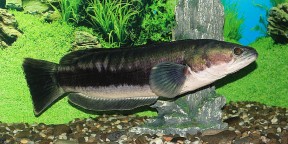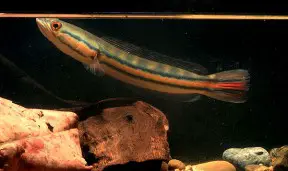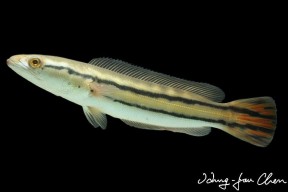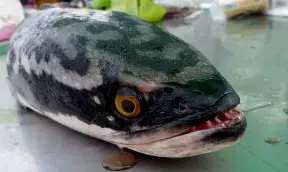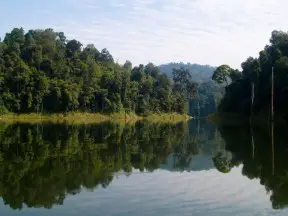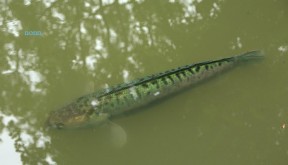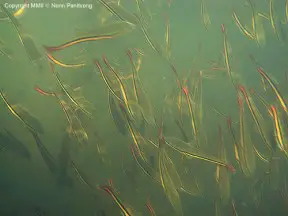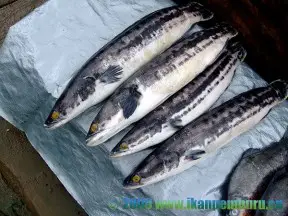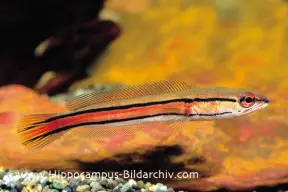Channa micropeltes
Giant Snakehead
SynonymsTop ↑
Ophicephalus micropeltes Cuvier, 1831; Ophicephalus serpentinus Cuvier, 1831; Ophicephalus bivittatus Bleeker, 1845; Ophicephalus stevensii Bleeker, 1854; Ophiocephalus studeri Volz, 1903; ? Ophiocephalus flos Pétillot, 1911
Etymology
Channa: from the Latin channe, used to refer to an unspecified species of sea perch.
micropeltes: from the Ancient Greek μικρός (mikros), meaning ‘small’, and πέλτη (péltē), meaning ‘shield’, in reference to the shield-like scales on the head of the fish.
Classification
Order: Perciformes Family: Channidae
Distribution
This species is widespread throughout much of Southeast Asia, with its range extending southwest from the Mekong River drainage in Laos, Thailand, Cambodia (including the Tonlé Sap system), and Vietnam, to central and southern (peninsular) Thailand, Peninsular Malaysia, Singapore, and the Greater Sunda Islands of Sumatra, Borneo, and Java. It also occurs in a number of smaller archipelagos including Bangka and Belitung (Billiton).
Type locality is ‘Java, Indonesia’.
C. micropeltes has been reported from U.S. several states including Maine, Massachusetts, Maryland, Rhode Island, Virginia, and Wisconsin, but is not thought to have become established due to its tropical requirements. Aquarium hobbyists are considered most likely to blame for these occurrences, having released the fish when they outgrew their home aquaria. It has also been introduced to the Philippines as a sport fish.
Habitat
Displays a preference for standing to slow-moving environments such as larger, deep, lowland river channels, inland lakes, and swamps, including man-made canals and reservoirs.
Maximum Standard Length
1000 – 1300 mm.
Aquarium SizeTop ↑
Suitable only for public installations or the very largest private aquaria.
Maintenance
Relatively unfussy although some surface cover in the form of floating or overhanging vegetation or branches is appreciated. Unlike most Channa spp. it is pelagic and requires plenty of room to swim.
It is essential to use a tightly-fitting hood since Channa spp. are notorious for their ability to escape, and a gap should be left between this and the water surface as they require access to a layer of humid air.
Water Conditions
Temperature: 20 – 30 °C
pH: 6.0 – 8.0
Hardness: 36 – 357 ppm
Diet
An obligate predator feeding on smaller fishes, amphibians, invertebrates and terrestrial insects in nature but in most cases adapts well to dead alternatives in captivity. Some specimens even accept dried foods though these should never form the staple diet.
Young fish can be offered chironomid larvae (bloodworm), small earthworms, chopped prawn and suchlike while adults will accept strips of fish flesh, whole prawns/shrimp, mussels, etc. Older individuals do not require feeding on a daily basis, with 2-3 times per week sufficient.
This species should not be fed mammalian or avian meat such as beef heart or chicken since some of the lipids contained in these cannot be properly metabolised by the fish and may cause excess fat deposits and even organ degeneration. Similarly there is no benefit in the use of ‘feeder’ fish such as livebearers or small goldfish which carry with them the risk of parasite or disease introduction, and tend not have a high nutritional value unless properly conditioned beforehand.
Behaviour and CompatibilityTop ↑
Best-maintained in a species-specific aquarium, but can apparently be maintained alongside similarly-sized fishes if sufficient space is available.
Juveniles and subadults are relatively peaceful with one another but become aggressive when they reach sexual maturity.
Sexual Dimorphism
There does not appear to be any reliable method to sex this species by external means.
Reproduction
Captive breeding has been achieved but an enormous amount of space and investment is required simply in order to produce a large number of juveniles with little-to-no monetary value. In addition, this species is said not to become sexually mature until approximately two years of age, by which point it should measure 50-60 cm in length.
Little has been published regarding the reproductive activity of wild fish, but apparently adults form pairs in flooded areas or small streams with submerged vegetation at the onset of the wet season. Some sources state that they build a nest in which to spawn, others that the eggs float at the water surface until they hatch, with the latter most likely given that the same strategy has been observed in some congeners.
Whereas adults exhibit a colour pattern comprising a broad, dark longitudinal stripe, juveniles possess two black longitudinal stripes with a bright orange area between, and once free swimming are gregarious and highly mobile. Parental care is relatively extended and the adults are extremely aggressive in defending their brood, with wild fish occasionally injuring humans. Older juveniles have been observed to form large aggregations, presumably as a means to reduce the threat posed by predators.
NotesTop ↑
C. micropeltes is also referred to as ‘Indonesian’, ‘red’, or ‘redline’ snakehead, the latter names in reference to the appearance of juveniles which often appear in the ornamental trade despite its unsuitability for home aquaria. It is somewhat hyperbolised in the media as a fearsome and invasive”monster” fish with a reputation for killing more fish than it can eat, and even the occasional human, although in reality there is no evidence for the latter and it has yet to become established anywhere outside Southeast Asia.
This species is heavily cultured throughout its native range, both as a sport fish and for human consumption, and is also used in medicine in some countries. Cage farming is the most common method employed, but it is now limited in Vietnam and banned in Cambodia due to the capture of countless small fish for use as food, many of which tend to be juveniles of commercially important species.
Some wild populations exhibit variations in colour pattern, and it is thought that the species as currently considered may contain hidden genetic diversity. Several broader genetic analyses of the genus Channa have already been published, and indicate that the sister species of C. micropeltes is the similar-looking C. diplogramma from southwestern India. These two species possess a region of gular scales that is present in only a few Asian Channa species but shared with the related African genus Parachanna, and it is hypothesised that this may be a plesiomorphic character.
C. micropeltes can be distinguished from C. diplogramma by a combination of characters as follows: shorter pre-anal length (mean 50.64 mm vs. 55.66 mm in C. diplogramma); deeper body (mean 20.05 cm vs. 15.60 cm); more cheek scales (23-25 vs. 16-20); more total vertebrae (57 vs. 53-54); less caudal-fin rays (14 vs. 15-17).
Members of the family Channidae are commonly referred to as ‘snakeheads’ due to possession of large scales on the head of most species which are reminiscent of the epidermal scales (cephalic plates) on the heads of snakes. There currently exist over 30 valid species but diversity within the group is likely to prove significantly greater.
All Channa spp. possess supplementary breathing apparatus in the form of paired suprabranchial chambers located behind and above the gills, although these are not labyrinthic but lined with respiratory epithelium. These chambers allow the fish to breathe atmospheric air and survive in hypoxic conditions or even out of the water for a considerable period of time, and in aquaria they are often seen rising to the surface to take gulps of air.
References
- Cuvier, in Cuvier & Valenciennes, 1831 - F. G. Levrault, Paris: i-xxix + 1-531
Histoire naturelle des poissons. Tome septième. Livre septième. Des Squamipennes. Livre huitième. Des poissons à pharyngiens labyrinthiformes. - Adamson, E. S., D. A. Hurwood, and P. B. Mather, 2010 - Molecular Phylogenetics and Evolution 56(2): 707-717
A reappraisal of the evolution of Asian snakehead fishes (Pisces, Channidae) 3 using molecular data from multiple genes and fossil calibration. - Benziger, A., S. Philip, R. Raghavan, P. H. Anvar Ali, M. Sukumaran, J. C. Tharian, N. Dahanukar, F. Baby, R. Peter, K. Rema Devi, K. V. Radhakrishnan, M. A. Aniffa, R. Britz, and A. Antunes, 2011 - PLoS ONE 6(6): e21272
Unraveling a 146 Years Old Taxonomic Puzzle: Validation of Malabar Snakehead, Species-Status and Its Relevance for Channid Systematics and Evolution. - Brede, N. and P. Antler, 2009 - Natur und Tier Verlag, Münster: 62 pp.
Schlangenkopffische—Die Gattungen Channa und Parachanna. - Courtenay, W. R., Jr. and J. D. Williams, 2004 - Circular, U. S. Department of the Interior, Geological Survey No. 1251: i-v + 1-143
Snakeheads (Pisces, Channidae) - a biological synopsis and risk assessment. - Freyhof, J., D. V. Serov and T. N. Nguyen, 2000 - Bonner Zoologische Beiträge 49(1-4): 93-99
A preliminary checklist of the freshwater fishes of the River Dong Nai, South Vietnam. - Kottelat, M., 2001 - WHT Publications, Colombo: 1-198
Fishes of Laos. - Kottelat, M., 2013 - Raffles Bulletin of Zoology Supplement 27: 1-663
The fishes of the inland waters of southeast Asia: a catalogue and core bibiography of the fishes known to occur in freshwaters, mangroves and estuaries. - Kottelat, M., 1998 - Ichthyological Exploration of Freshwaters 9(1): 1-128
Fishes of the Nam Theun and Xe Bangfai basins, Laos, with diagnoses of twenty-two new species (Teleostei: Cyprinidae, Balitoridae, Cobitidae, Coiidae and Odontobutidae). - Kottelat, M. and E. Widjanarti, 2005 - Raffles Bulletin of Zoology Supplement 13: 139-173
The fishes of Danau Sentarum National Park and the Kapuas Lakes area, Kalimantan Barat, Indonesia. - Lim, K. K. P., P. K. L. Ng and M. Kottelat, 1990 - Bulletin of the Raffles Museum 38(1): 31-54
On a collection of freshwater fishes from Endau-Rompin, Pahang-Johore, Peninsular Malaysia. - Ng, H. H. and H.-H. Tan, 1999 - Zoological Studies 38(3): 350-366
The fishes of the Endau drainage, Peninsular Malaysia with descriptions of two new species of catfishes (Teleostei: Akysidae, Bagridae). - Rainboth, W. J., 1996 - Rome, FAO: 1-265
FAO species identification field guide for fishery purposes. Fishes of the Cambodian Mekong. - Roberts, T. R., 1993 - Zoologische Verhandelingen (Leiden) 285: 1-94
The freshwater fishes of Java, as observed by Kuhl and van Hasselt in 1820-23. - Roberts, T. R., 1989 - Memoirs of the California Academy of Sciences 14: i-xii + 1-210
The freshwater fishes of western Borneo (Kalimantan Barat, Indonesia). - Serrao, N. R., D. Steinke, and R. H. Hanner, 2014 - PLoS ONE 9(6): e99546
Calibrating Snakehead Diversity with DNA Barcodes: Expanding Taxonomic Coverage to Enable Identification of Potential and Established Invasive Species. - Tan, H. H. and M. Kottelat, 2009 - Ichthyological Exploration of Freshwaters 20(1): 13-69
The fishes of the Batang Hari drainage, Sumatra, with description of six new species. - Tan, H. H. and P. K. L. Ng, 2005 - Raffles Bulletin of Zoology Supplement 13: 115-138
The labyrinth fishes (Teleostei: Anabanatoidei, Channoidei) of Sumatra, Indonesia.

